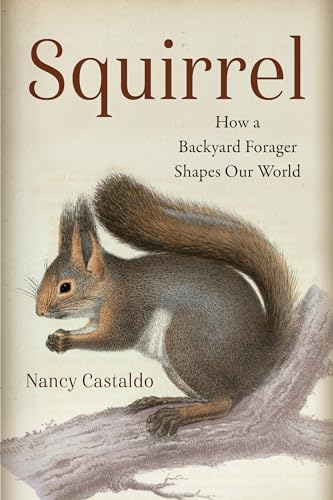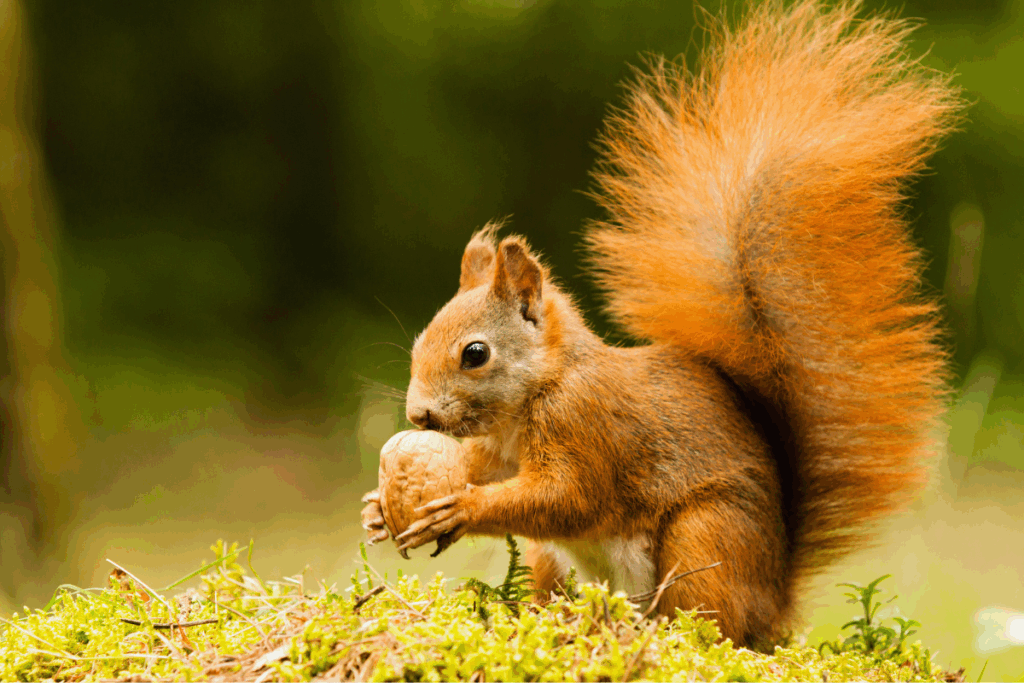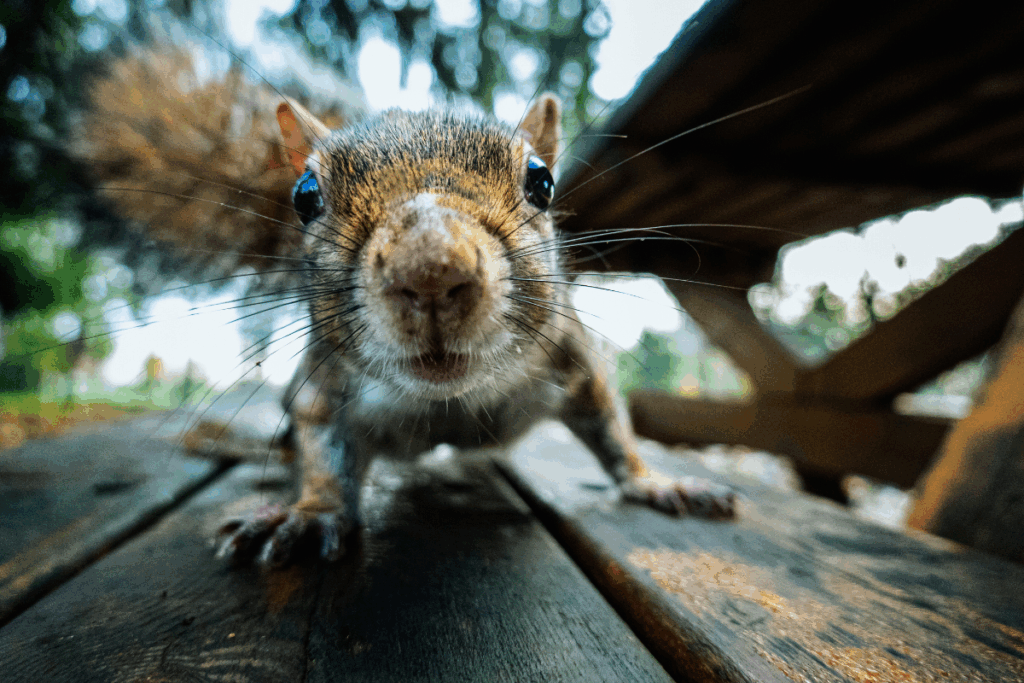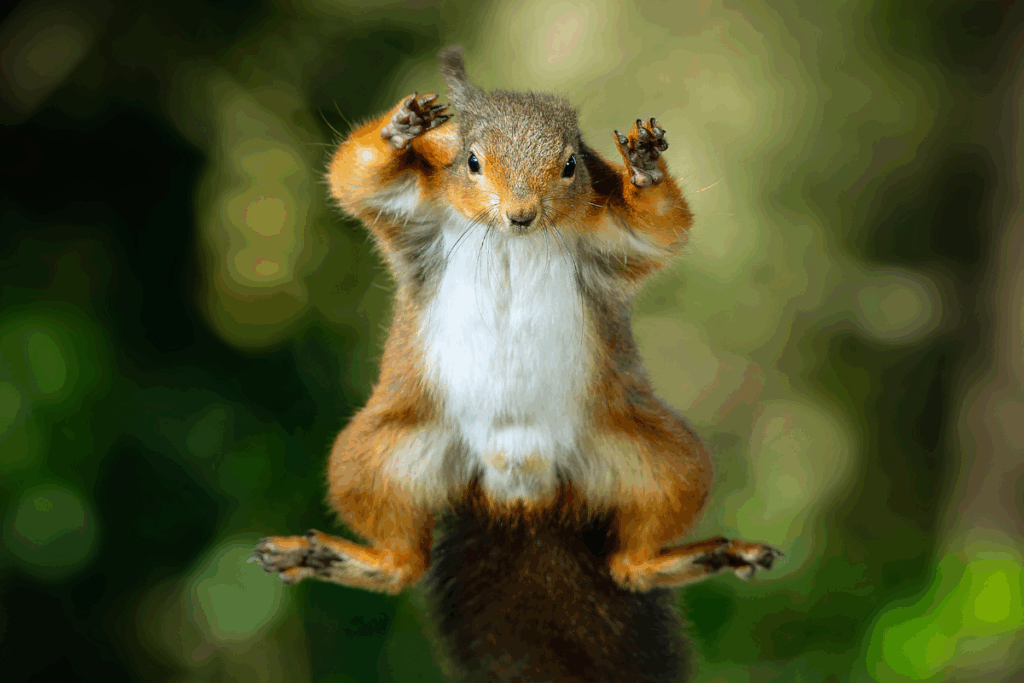When Forgetfulness Grows Forests: The Ecological Genius of Squirrels
Bioneers | Published: October 28, 2025 Nature, Culture and Spirit Article

In forests across North America, a humble forager shapes ecosystems in ways few people notice. Squirrels, with their endless caching and forgetfulness, are not just entertaining backyard acrobats; they’re essential engineers of our forests. Every nut they bury and fail to retrieve plants the possibility of a future tree, a quiet act of reforestation repeated millions of times over.
In Squirrel: How a Backyard Forager Shapes Our World, author Nancy F. Castaldo invites readers to see these small mammals as more than scatterbrained hoarders. Through wit, history, and ecology, she reveals the profound intelligence behind their behavior and their role as keystone species sustaining the health of entire ecosystems.
In this excerpt from Chapter One, “As a Keystone Species,” Castaldo explores how the squirrel’s “enhanced” cognitive abilities, instinctive drive for survival, and sometimes-forgotten food caches knit together the forest’s living architecture — proving that even the smallest creatures can hold up the biggest systems.
“Keystone: a central stone at the summit of an arch, locking the whole together.”
—Oxford English Dictionary
“I learned a fun fact about squirrels. . . . Squirrels cannot find 80 percent of the nuts they hide. Are you kidding me? Is that the greatest thing you’ve ever heard in your life? First of all, animals aren’t supposed to make mistakes. But secondly, I made this realization. . . . Hold your skulls in, because your brains are gonna [f***ing] explode. That’s how trees are planted,” pronounced comedian Sarah Silverman.
Ernest Thompson Seton, naturalist and pioneering founder of the Boy Scouts of America, wrote in the foreword to his 1922 animal-fiction story Bannertail: The Story of a Graysquirrel, “In the nut forests of America, practically every tree was planted by the Graysquirrel, or its kin. No squirrels, no nut-trees.” While Seton often anthropomorphized his animals with the human qualities of curiosity, desire, and sympathy, garnering negative and vocal criticism from other naturalists, his observations should not be discounted.

Is Seton or Silverman correct? Perhaps both or neither. Plants rely on seed dispersal for their survival. While some plants have seeds that fly away in the wind, many need a creature, such as a bird or squirrel, to carry away the seed. Whether a seed is picked up on fur and brought inadvertently to a new location, excreted after being eaten, or carried away and planted in the earth, plants have relationships with dispersers. These relationships are crucial to the survival of forest ecosystems; they are crucial to our own survival. Evidence of a seed dispersal crisis in Europe in 2024 indicated that for 30 percent of plant species, most of their dispersers are threatened or declining, demonstrating how vital seed dispersers, such as squirrels, are in our world.
Squirrels are dispersers. They do plant trees, but the process is more complex than both Silverman’s and Seton’s pronouncements. Squirrels have used their skill at finding food to their advantage, and this demonstrates an “enhanced” cognitive ability. Their food-caching behavior does not lack purpose or direction. And so we must consider the brains of squirrels, how squirrels contribute to the health of our forests, and their role as keystone species.
“Not much goes on in the mind of a squirrel. Huge portions of what is loosely termed ‘the squirrel brain’ are given over to one thought: food,” wrote Kate DiCamillo in Flora and Ulysses, a novel centered on a girl and a squirrel that won the John Newbery Medal in 2014. DiCamillo wasn’t wrong in describing squirrels’ focus and behavior toward food. But that drive for sustenance is present among most animals. From wolves to pelicans, wild creatures constantly think about their next meal. It’s a matter of survival. Squirrels aren’t an exception. Without that drive for sustenance, they perish. But there is more to the squirrel brain than DiCamillo’s description suggests.
Squirrel brain is often used as a derogatory metaphor for someone having scattered and fuzzy thinking without much depth or connection. The truth is much different. Squirrel brains, about the size of a walnut, are substantially more complex. Just as scientists have observed in other creatures, there is a great deal we are uncovering about animal brains and cognition. Squirrel brains are quite large compared with the size of their bodies, quite larger than those of other rodents. This ratio, comparable to that of many primates, demonstrates cognition complexity. This complexity is seen in the way they group their nuts. Squirrels use the method of “spatial chunking,” keeping their nuts grouped according to type, to help them remember where they are stashed. Walnuts with walnuts. Hazelnuts with hazelnuts. They also group nuts by size. This is not fuzzy thinking.

Noted US squirrel researcher Michael Steele, along with researchers from Germany and the United Kingdom, explored the “enhanced” cognitive ability of gray squirrels. While they found that some cognitive abilities in gray squirrels, such as solving novel problems, has undergone mild variation as they have adapted to new environments, the previously reported enhanced performance is likely a general characteristic that brings fitness advantages to this species and contributes to their adaptability to new environments. Squirrels demonstrate exceptional problem-solving abilities and have a complex communication system that includes both sound and scent to share information of threats and food sources. “Squirrel brain,” then, is far from scattered and fuzzy. And having that brain also has a huge impact on our forests.
In Bannertail, Seton captured a squirrel’s robust autumn food drive: “No longer wabbly or vague, as in that first autumn, but fully aroused and dominating was the instinct to gather and bury every precious, separate nut. Bannertail had had to learn slowly and partly by seeing the Redsquirrels making off with the prizes. But he had learned, and his brood had the immediate stimulus of seeing him and their mother at work; and because he was of unusual force, it drove him hard, with an urge that acted like a craze. He worked like mad, seizing, stripping, smelling, appraising, marking, weighing every nut he found.”
Anyone, like Seton, who has observed squirrels during autumn can relate to Bannertail’s urge that made him act in a “craze” to gather nuts. The urgency squirrels exhibit not only enables them to feed throughout the cold months ahead; their behavior also builds forests.
This wasn’t the first time Seton wrote about squirrels. A decade earlier, he included squirrels among sixty mammalian wildlife species in Life-Histories of Northern Animals: An Account of the Mammals of Manitoba. Most of his remarks that follow the sections on classification are his personal observations or those of his friends and colleagues. “I am informed by A. K. Fisher that at the southern end at Lake George, in early autumn, it is sometimes an everyday occurrence to see Red-squirrels swimming across the lake, from west to east (about two miles)—never in the opposite direction. The chestnut grows abundantly on the eastern side of the lake, but it is comparatively scarce on the western, and these extensive migrations always take place in years when the yield of chestnuts is large.”
Lake George is a thirty-two-mile-long lake in northern New York state’s Adirondack Mountains. The mountains make up the southern part of the Eastern Temperate Forests ecoregion, which extends into Maine and eastern Canada and is home to the state’s Adirondack Park Forest Preserve. The forests in the park and around Lake George consist of hemlocks, spruces, beeches, pines, and broad-leaved trees. Red squirrels, as well as eastern gray squirrels and two species of flying squirrels, make their home in the forests along with a host of other mammals, including moose, deer, and beavers.
A. K. Fisher’s observations of chestnut-searching swimming squirrels in Lake George were not the only observations in the Adirondacks. Early studies of red squirrels in the mountains reported sightings of squirrels swimming across Big Moose Lake, Long Lake, Brantingham Lake, and Lake George. Seton also included James Higby’s observation of June 1877; Higby witnessed as many as fifty squirrels crossing Big Moose Lake.
Another account was documented in Winslow Watson’s history of Essex County: “The autumn of 1851 afforded one of these periodical invasions of Essex County. It is well authenticated, that the red-squirrel was constantly seen in the widest parts [about seven miles] of [Lake Champlain], far out from land, swimming towards the shore, as if familiar with the service; their heads above water, and their bushy tails erect and expanded, and apparently spread to the breeze. Reaching land, they stopped for a moment, and relieving their active and vigorous little bodies from the water, by an energetic shake or two, they bounded into the woods, as light and free as if they had made no extraordinary effort.”

The massive chestnut trees at the Adirondack lake were appreciated not only by native squirrel species; they also appeared in many works of art at the turn of the century, including Robert Melvin Decker’s Old Chestnuts at Bolton, Lake George, circa 1890–95. Alfred Stieglitz captured a dying chestnut tree on the eastern edge of Lake George in a 1927 photograph. None of this art captured swimming or climbing squirrels.
However, those chestnut trees, a boon for American red squirrels, were doomed when the nonnative Chinese chestnut tree entered the United States with a lethal fungus.
On an autumn day roughly a century after Stieglitz took that photo, I sat near that site at the southern end of Lake George, reading Diane Ackerman’s passages about squirrels in her book Cultivating Delight.
As with my many other visits to the lake over the years, I did not witness a single red or gray squirrel swimming in the lake. I also haven’t seen those majestic chestnuts that propelled the swimming behavior that Seton memorialized in 1909. The lack of chestnut trees altered the composition of the forests and the behavior of the wildlife that depended on them.
Fortunately, those American red squirrels did not completely rely on the chestnuts for their survival. But it is easy to see how we could have had a different outcome with the population of our common squirrels.
These days, post chestnut tree habitation, red squirrels harvest seeds from Adirondack conifers, including pines, spruces, and firs. They also feed on birch catkins and sugar maple bark and seeds. The Adirondack forests also provide them with nuts from beaked hazelnut and American hazelnut and the berries of northern wild raisin, wintergreen, and partridgeberry. They are regularly seen on all forest trails.
From Squirrel: How a Backyard Forager Shapes Our World by Nancy F. Castaldo. Copyright © 2025 Nancy F. Castaldo. Reproduced by permission of Island Press, Washington, D.C.
